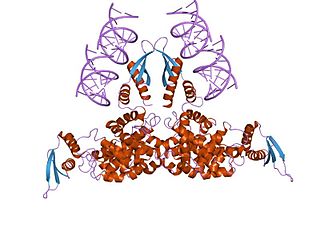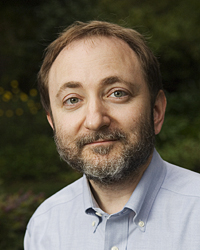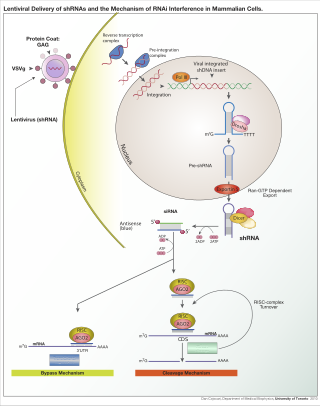Related Research Articles
Deamination is the removal of an amino group from a molecule. Enzymes that catalyse this reaction are called deaminases.
Gene silencing is the regulation of gene expression in a cell to prevent the expression of a certain gene. Gene silencing can occur during either transcription or translation and is often used in research. In particular, methods used to silence genes are being increasingly used to produce therapeutics to combat cancer and other diseases, such as infectious diseases and neurodegenerative disorders.

Small interfering RNA (siRNA), sometimes known as short interfering RNA or silencing RNA, is a class of double-stranded RNA at first non-coding RNA molecules, typically 20–24 base pairs in length, similar to miRNA, and operating within the RNA interference (RNAi) pathway. It interferes with the expression of specific genes with complementary nucleotide sequences by degrading mRNA after transcription, preventing translation.

Dicer, also known as endoribonuclease Dicer or helicase with RNase motif, is an enzyme that in humans is encoded by the DICER1 gene. Being part of the RNase III family, Dicer cleaves double-stranded RNA (dsRNA) and pre-microRNA (pre-miRNA) into short double-stranded RNA fragments called small interfering RNA and microRNA, respectively. These fragments are approximately 20–25 base pairs long with a two-base overhang on the 3′-end. Dicer facilitates the activation of the RNA-induced silencing complex (RISC), which is essential for RNA interference. RISC has a catalytic component Argonaute, which is an endonuclease capable of degrading messenger RNA (mRNA).
The RNA-induced silencing complex, or RISC, is a multiprotein complex, specifically a ribonucleoprotein, which functions in gene silencing via a variety of pathways at the transcriptional and translational levels. Using single-stranded RNA (ssRNA) fragments, such as microRNA (miRNA), or double-stranded small interfering RNA (siRNA), the complex functions as a key tool in gene regulation. The single strand of RNA acts as a template for RISC to recognize complementary messenger RNA (mRNA) transcript. Once found, one of the proteins in RISC, Argonaute, activates and cleaves the mRNA. This process is called RNA interference (RNAi) and it is found in many eukaryotes; it is a key process in defense against viral infections, as it is triggered by the presence of double-stranded RNA (dsRNA).

Ribonuclease III (RNase III or RNase C)(BRENDA 3.1.26.3) is a type of ribonuclease that recognizes dsRNA and cleaves it at specific targeted locations to transform them into mature RNAs. These enzymes are a group of endoribonucleases that are characterized by their ribonuclease domain, which is labelled the RNase III domain. They are ubiquitous compounds in the cell and play a major role in pathways such as RNA precursor synthesis, RNA Silencing, and the pnp autoregulatory mechanism.

Andrew Zachary Fire is an American biologist and professor of pathology and of genetics at the Stanford University School of Medicine. He was awarded the 2006 Nobel Prize in Physiology or Medicine, along with Craig C. Mello, for the discovery of RNA interference (RNAi). This research was conducted at the Carnegie Institution of Washington and published in 1998.

The Argonaute protein family, first discovered for its evolutionarily conserved stem cell function, plays a central role in RNA silencing processes as essential components of the RNA-induced silencing complex (RISC). RISC is responsible for the gene silencing phenomenon known as RNA interference (RNAi). Argonaute proteins bind different classes of small non-coding RNAs, including microRNAs (miRNAs), small interfering RNAs (siRNAs) and Piwi-interacting RNAs (piRNAs). Small RNAs guide Argonaute proteins to their specific targets through sequence complementarity, which then leads to mRNA cleavage, translation inhibition, and/or the initiation of mRNA decay.

Drosha is a Class 2 ribonuclease III enzyme that in humans is encoded by the DROSHA gene. It is the primary nuclease that executes the initiation step of miRNA processing in the nucleus. It works closely with DGCR8 and in correlation with Dicer. It has been found significant in clinical knowledge for cancer prognosis and HIV-1 replication.
RNA silencing or RNA interference refers to a family of gene silencing effects by which gene expression is negatively regulated by non-coding RNAs such as microRNAs. RNA silencing may also be defined as sequence-specific regulation of gene expression triggered by double-stranded RNA (dsRNA). RNA silencing mechanisms are conserved among most eukaryotes. The most common and well-studied example is RNA interference (RNAi), in which endogenously expressed microRNA (miRNA) or exogenously derived small interfering RNA (siRNA) induces the degradation of complementary messenger RNA. Other classes of small RNA have been identified, including piwi-interacting RNA (piRNA) and its subspecies repeat associated small interfering RNA (rasiRNA).

Sir David Charles Baulcombe is a British plant scientist and geneticist. As of 2017 he is a Royal Society Research Professor. From 2007 to 2020 he was Regius Professor of Botany in the Department of Plant Sciences at the University of Cambridge.

The double-stranded RNA-specific adenosine deaminase enzyme family are encoded by the ADAR family genes. ADAR stands for adenosine deaminase acting on RNA. This article focuses on the ADAR proteins; This article details the evolutionary history, structure, function, mechanisms and importance of all proteins within this family.

Double-stranded RNA-specific editase 1 is an enzyme that in humans is encoded by the ADARB1 gene. The enzyme is a member of ADAR family.

Bladder cancer-associated protein is a protein that in humans is encoded by the BLCAP gene.
Thomas Tuschl is a German biochemist and molecular biologist, known for his research on RNA.

RNA interference (RNAi) is a biological process in which RNA molecules are involved in sequence-specific suppression of gene expression by double-stranded RNA, through translational or transcriptional repression. Historically, RNAi was known by other names, including co-suppression, post-transcriptional gene silencing (PTGS), and quelling. The detailed study of each of these seemingly different processes elucidated that the identity of these phenomena were all actually RNAi. Andrew Fire and Craig C. Mello shared the 2006 Nobel Prize in Physiology or Medicine for their work on RNAi in the nematode worm Caenorhabditis elegans, which they published in 1998. Since the discovery of RNAi and its regulatory potentials, it has become evident that RNAi has immense potential in suppression of desired genes. RNAi is now known as precise, efficient, stable and better than antisense therapy for gene suppression. Antisense RNA produced intracellularly by an expression vector may be developed and find utility as novel therapeutic agents.

Mary C. Beckerle is an American cell biologist who studies cancer at the Huntsman Cancer Institute at the University of Utah School of Medicine. At Huntsman Cancer Institute, she serves as the CEO and also as Associate Vice President for Cancer Affairs at the University of Utah. Beckerle's research helped to define a novel molecular pathway for cell motility, and more recently, she has begun research into Ewing’s sarcoma, a pediatric bone cancer. Beckerle's lab made a ground breaking discovery in regards to Ewing's Sarcoma in relation to the EWS/FLI protein. Her lab discovered EWS/FLI to disrupt the internal cellular skeleton, which decreases the ability of cells to adhere to their proper environment. This can help explain the metastasis of tumors in patients with Ewing's sarcoma.
Cornelia "Neli" Ulrich is executive director of the Comprehensive Cancer Center at Huntsman Cancer Institute (HCI), Jon M. and Karen Huntsman Presidential Professor in Cancer Research, and former Division Chief of Cancer Population Sciences in the Department of Population Health Sciences at the University of Utah. Ulrich oversees HCI's academic consortium of nearly 200 cancer research teams. She leads efforts to advance the impact of HCI's research in laboratory, clinical and population science, with the goal of improving cancer prevention and treatment. Prior to joining HCI, she was the director and department head of preventive oncology at the National Center of Tumor Diseases (NCT) and German Cancer Research Center (DKFZ) in Heidelberg. During this time, she also held a Professorship at the DKFZ and University of Heidelberg. From 1993 until 2009, Ulrich was a Member of the Fred Hutchinson Cancer Research Center and Professor in Epidemiology at the University of Washington in Seattle.

Phillip D. Zamore is an American molecular biologist and developed the first in vitro system for studying the mechanism of RNA interference (RNAi). He is the Gretchen Stone Cook Professor of Biomedical Sciences and Professor of Biochemistry and Molecular Pharmacology at University of Massachusetts Chan Medical School, located in Worcester, Massachusetts. Zamore is the chair of the RNA Therapeutics Institute (RTI) at UMass Chan Medical School, established in 2009, and has been a Howard Hughes Medical Institute Investigator since 2008.

LEAPER is a genetic engineering technique in molecular biology by which RNA can be edited. The technique relies on engineered strands of RNA to recruit native ADAR enzymes to swap out different compounds in RNA. Developed by researchers at Peking University in 2019, the technique, some have claimed, is more efficient than the CRISPR gene editing technique. Initial studies have claimed that editing efficiencies of up to 80%.
References
- 1 2 3 4 5 "Road Less Traveled Leads to National Academy of Sciences for Biochemist Brenda L. Bass, Ph.D." University of Utah. 28 April 2015. Retrieved 17 January 2017.
- 1 2 3 "Brenda L. Bass, Ph.D., Endowed Chair". University of Utah School of Medicine Benning Society. Archived from the original on 18 January 2017. Retrieved 17 January 2017.
- 1 2 3 "Brenda L. Bass, Ph.D." University of Utah School of Medicine. Retrieved 17 January 2017.
- ↑ "Cancer Investigators". Huntsman Cancer Institute. Retrieved 17 January 2017.
- 1 2 3 4 5 "Brenda L. Bass Curriculum Vitae" (PDF). University of Utah. Retrieved 17 January 2017.
- ↑ "Research". Brenda L. Bass Lab. Retrieved 17 January 2017.
- ↑ "Alnylam Granted Summary Judgment by United States District Court for the District of Massachusetts in Tuschl II Patent Inventorship Dispute". BusinessWire. 28 September 2015. Retrieved 17 January 2017.
- ↑ Bass, Brenda L. (16 March 2015). "Twenty years: a very short sequence in the RNA world". RNA. 21 (4): 490–491. doi:10.1261/rna.050856.115. PMC 4371250 . PMID 25780108.
- ↑ "Brenda L. Bass, Ph.D." Howard Hughes Medical Institute. Retrieved 17 January 2017.
- ↑ "NIH honors Utah biochemist with Pioneer Award for dsRNA research". News-Medical.Net. 23 September 2011. Retrieved 17 January 2017.